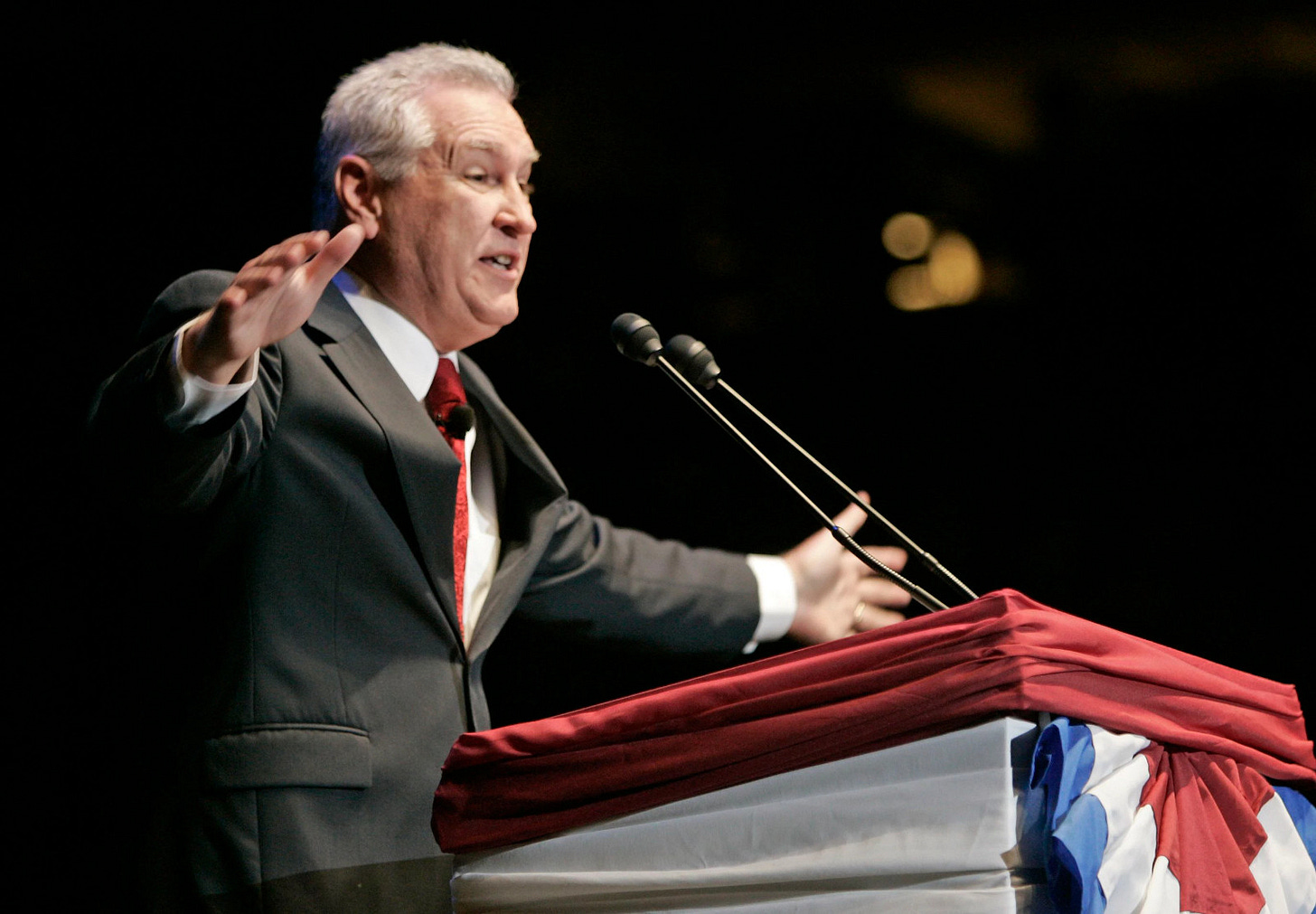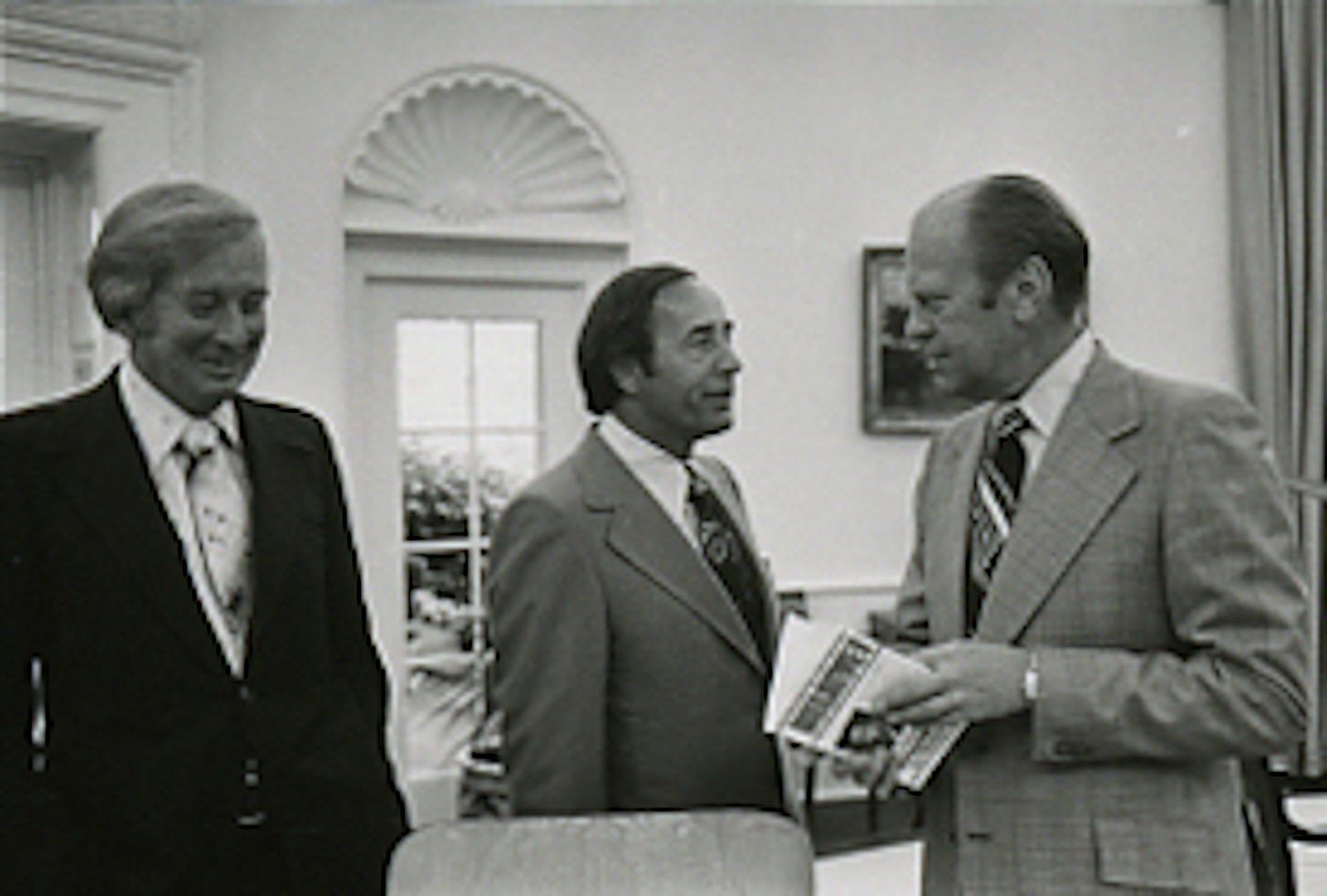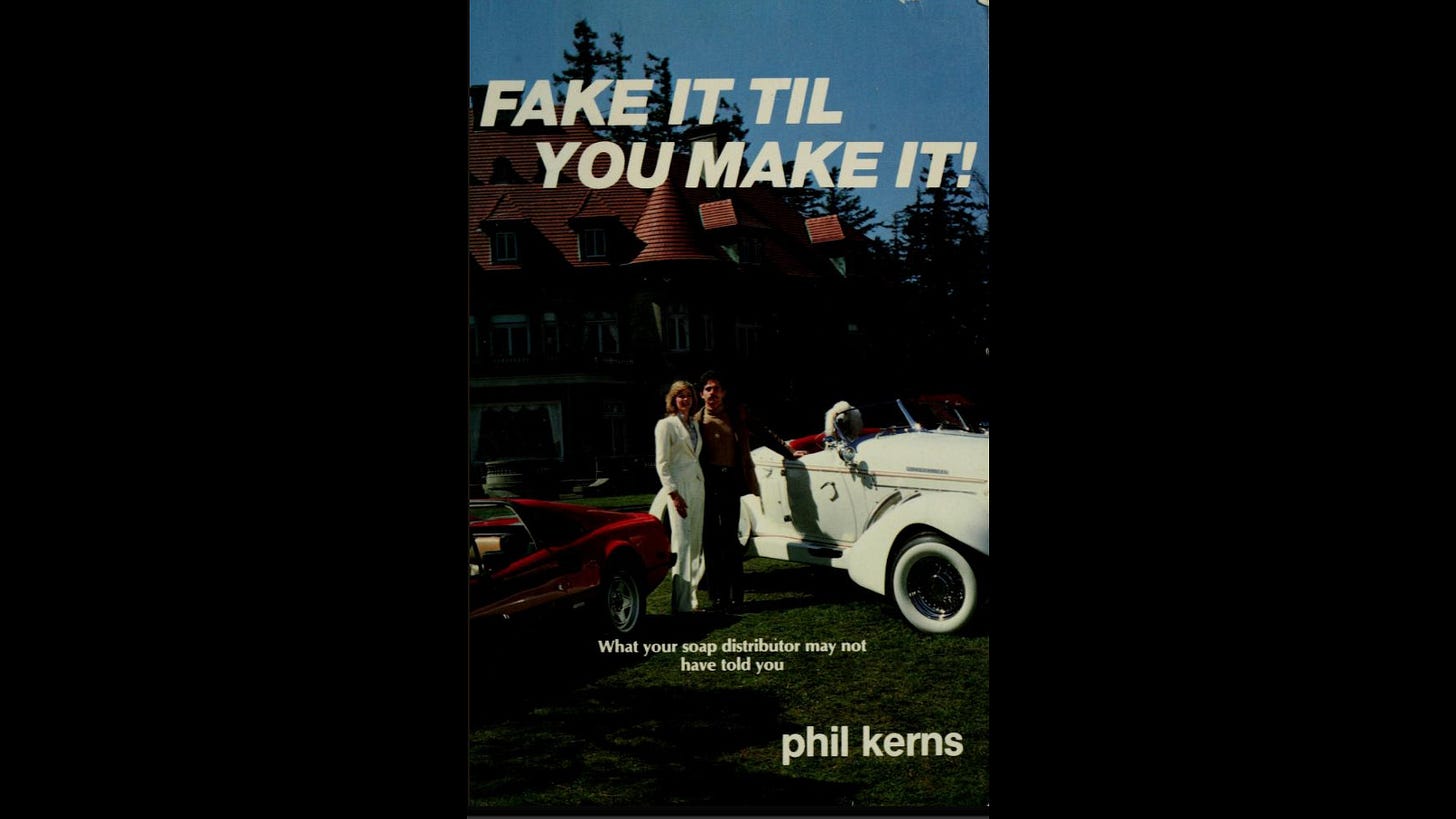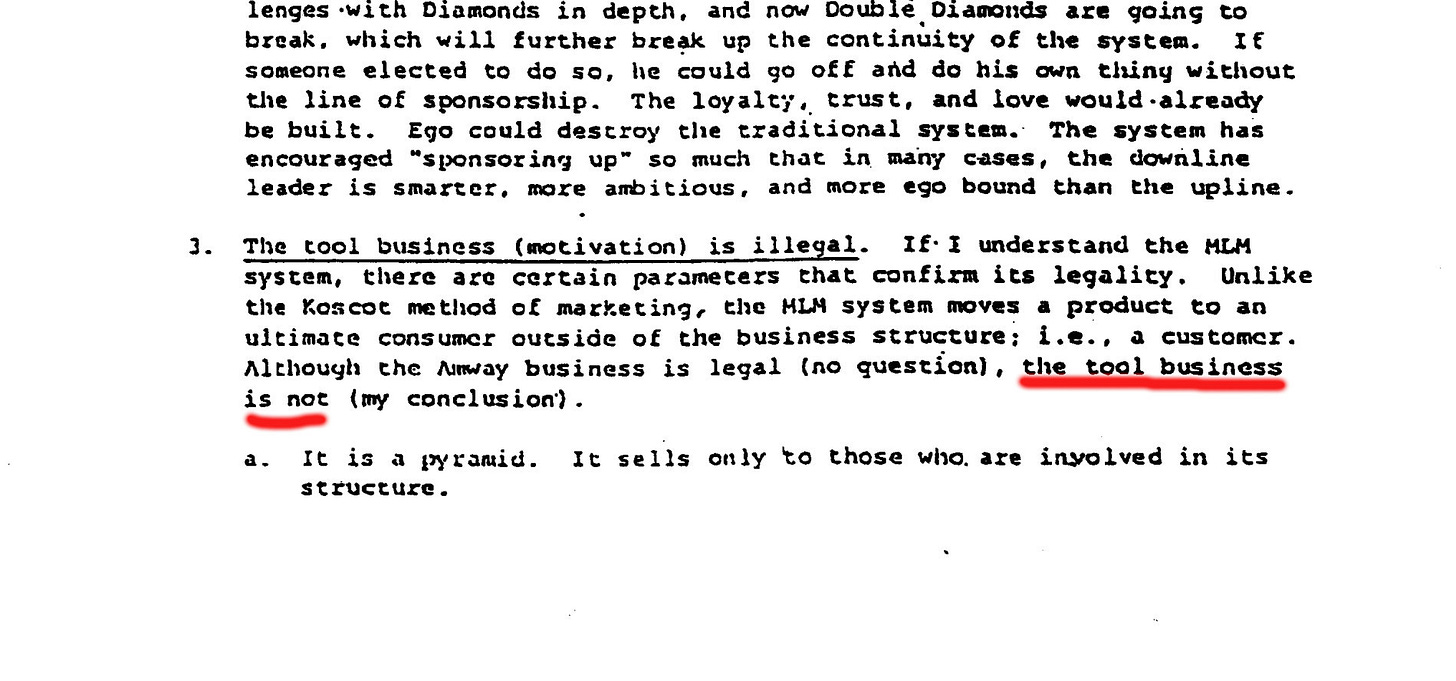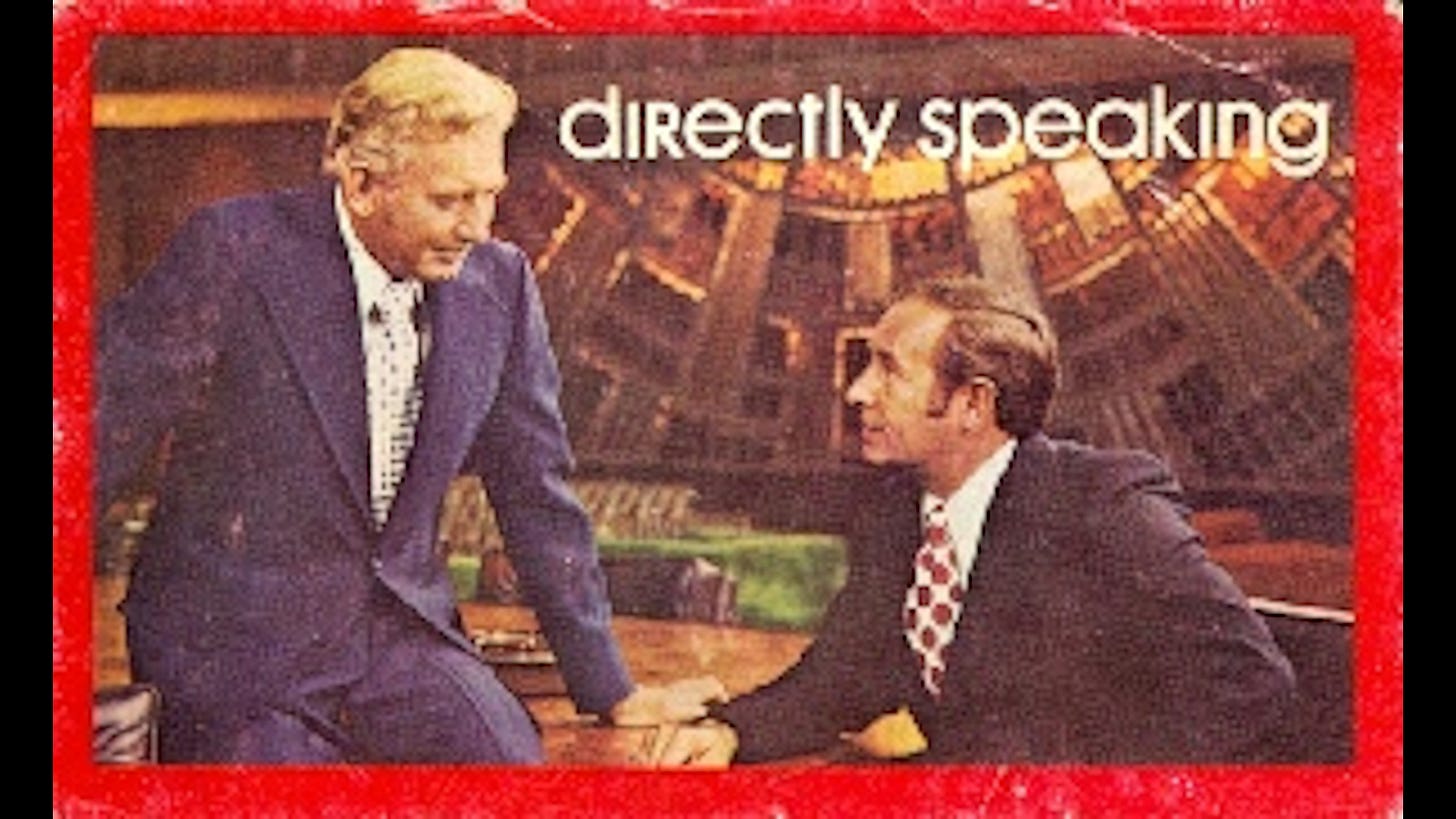The Tools Cult: The History of the Amway Motivational Scam. (Part 2 of 3)
The continuing story of one of the biggest grifts in recent American history, which raked in hundreds of millions and left desperate MLM scam victims brainwashed and ripped off.
This series of articles is adapted from my in-depth video on the subject, available on my YouTube channel, available here. This is part two of three. Part one, released yesterday, is here. The third and final chapter will be posted tomorrow.
In 1964, the same year Dexter Yager got into Amway, a man named William Penn Patrick founded a cosmetics sales company called Holiday Magic, Inc.1 Using the Amway multilevel marketing model, Patrick sold distributorships in Holiday Magic, which was one of the early—and infamous—multilevel marketing pyramid schemes. But even the sale of distributorships and cosmetics took a back seat to Patrick’s true business, which was selling motivation.
In 1967 Patrick founded Leadership Dynamics, a for-profit company that pioneered the technique of Large Group Awareness Training. Patrick also had a financial stake in a similar company called Mind Dynamics, founded by his mentor, Alexander Everett. The ideology of these groups was highly similar to the kind of motivational material made popular by Earle Nightingale, Dexter Yager’s spiritual mentor. Mind Dynamics was also called a cult. Subjecting its members to humiliation, verbal and physical abuse and even being locked into coffins, this company was the subject of a notorious 1972 book-length expose2—while in the meantime Holiday Magic was being prosecuted by the State of California, the Securities & Exchange Commission, and the FTC for being an illegal pyramid scheme. These companies shut down after Patrick’s death in 1973.
The story of William Penn Patrick illustrates an early connection between multilevel marketing and ultraconservatism. Patrick was a member of the infamous John Birch Society, which has also been likened to a cult—a far-right-wing organization that believes in a worldwide Communist conspiracy. The modern conspiracy theory cult QAnon has a lot of intellectual roots—if you could call them that—in common with the John Birch Society.3 Jon Schaffer, the former lead singer of the heavy metal band Iced Earth, who went to prison for his participation in the January 6, 2021 insurrection at the Capitol, told the media that his anti-government views were heavily shaped by his father who was a longtime member of the John Birch Society.4
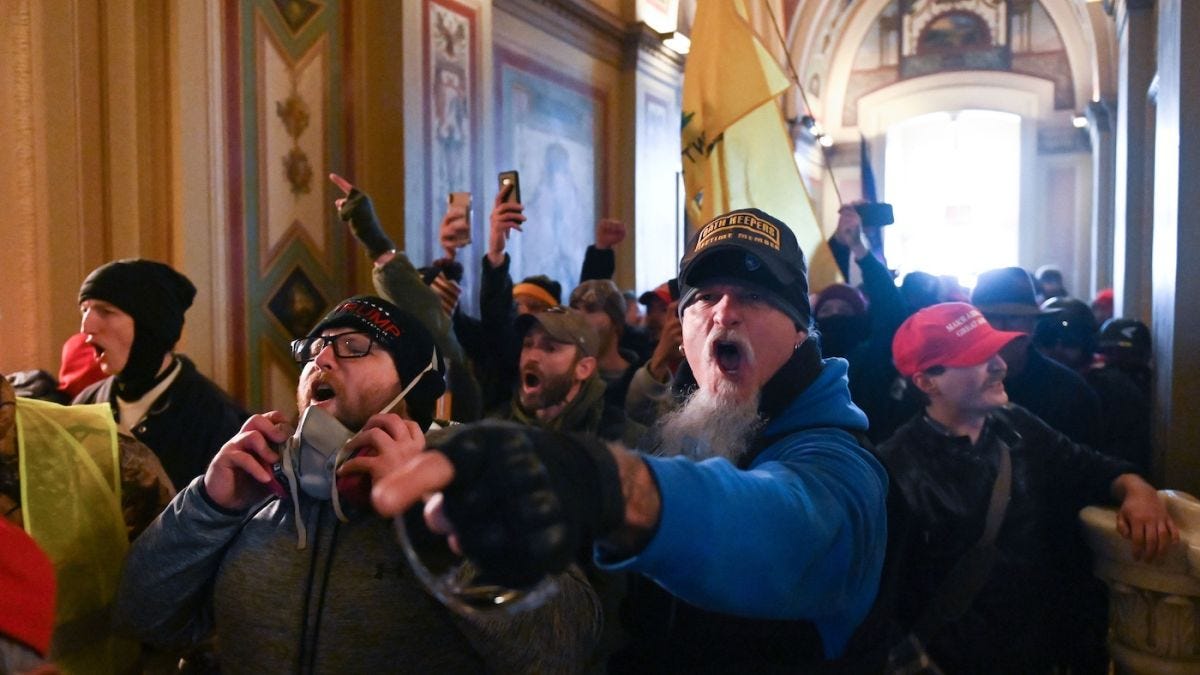
For a time an employee of William Penn Patrick’s Holiday Magic scheme was one Glenn W. Turner, who went on to found his own multilevel marketing pyramid—the infamous Koscot Interplanetary, Inc. Koscot, like Holiday Magic, also ostensibly sold cosmetics—the name was apparently meant to reference both the word “cosmetics,” and Florida’s soon-to-be-built city of the future Epcot Center, with the word “interplanetary” added to give it a futuristic feel.5 In 1969—the year Dexter Yager moved to Charlotte, North Carolina—Turner founded a company called Dare To Be Great, Inc.!. Based in Orlando—the home territory of Epcot Center, then in the early stages of development—Dare to be Great! sold a series of self-motivation courses, provided mostly on cassette tapes. The courses were graduated and increasingly more expensive, from Adventure I to Adventure IV—the resemblance to Scientology’s “Operating Thetan” levels is probably not a coincidence—and to get through all four would cost the customer $8000 dollars, the equivalent of over $61,000 in today’s money.
What was the basic message of all these expensive Adventure courses, bellowed at the customer on tape in Glenn W. Turner’s classic Southern twang?
All things are possible to him who believes. What does it take to become a success? Believing in yourself. Making a million dollars was easy. What was the hardest thing in the world? Believing I could do it.6
If this sounds remarkably like the message Dexter Yager began pushing only a few years later, it should.
Glenn W. Turner amassed a fortune of $150 million selling Dare To Be Great! on the multilevel pyramid model. It didn’t last. Koscot Interplanetary was driven out of business by the FTC in 1975 for being an illegal pyramid scheme, but not before tarring celebrity lawyer F. Lee Bailey, later partially responsible for freeing double murderer O.J. Simpson. Bailey was indicted on conspiracy charges related to Koscot, together with Turner, in 1973; that case ended in a hung jury. Turner eventually went to prison in 1987 for running a different pyramid scheme. He died in 2020.
Why is any of this relevant to the Amway tools cult? Several reasons. First, the Koscot experience in particular demonstrates that there was significant profit potential in selling motivation as a commodity, particularly in the medium of cassette tapes. And seminars and rallies too, both of which Holiday Magic and Koscot had. There’s a natural affinity, for whatever reason, between multilevel pyramid marketing and motivational material that often has a cult-like effect.
Second, the connections between motivational cults, multi-level marketing and far-right politics are also evident in stories of these early pyramid schemes. Nearly all of the tools cult kingpins would turn out to be conservative evangelical Republicans, especially Dexter Yager, which had far-reaching consequences as we’ll see in the next installment.
Third, so long as we’re talking about connections, there are numerous layers of connection between these organizations and others in what you might call the “human potential movement” of the 1970s—which included Erhard Seminars Training, or est, founded by Werner Erhard, who was involved in Mind Dynamics, the sister corporation of Holiday Magic. While it seems bizarre now, for a time the Church of Scientology was popularly believed to be a part of this movement.7 This kind of ideology was everywhere in the ‘70s. Est even showed up in the 1978 musical film The Wiz, the all-Black remake of The Wizard of Oz, imported into the production by Diana Ross, a follower of Werner Erhard.
And finally, several former Koscot distributors eventually wound up in Amway—and some apparently became tools cult kingpins. Koscot is mentioned casually on the Miami showdown tape from 1983, demonstrating that the kingpins were fully aware of it.
Doug Wead, The Man at the Center
As you recall—before we delved into the histories of Holiday Magic, Koscot Interplanetary and the other motivational cults of the ‘70s—Dexter Yager and Bill Britt had struck it big in the tape business after a fateful meeting, sometime in 1970 or 1971, at Miami’s Fontainebleau Hotel, and at this meeting a “young man who will remain nameless” suggested to Britt that he invest $50,000 in the tape duplicating business.
The source for that account was one Douglas Wead, who is a fascinating, chameleon-like figure weaving his way in and out of this story.8 Wead, born in Indiana in 1946, was a lifelong Pentecostal and Assemblies of God preacher before he started to become prominent as a motivational speaker in the mid-1970s, which is apparently how he came to the attention of various Amway personalities—including Dexter Yager. Wead was employed by Yager as his assistant, press agent and ghostwriter. They co-authored numerous motivational books that were pushed out as tools to Amway distributors, and Wead wrote the first book under Yager’s byline, the 1978 “classic” Don’t Let Anybody Steal Your Dream. One can read this book in about fifteen minutes. It’s an absolute nothingburger in terms of content, but completely reflective of the cultic style of tapes and rallies which was big business by that time.
Doug Wead, in fact, coined the phase “compassionate capitalism,” which was later used by Amway corporate co-founder Rich DeVos as the title of a 1994 book—marketed heavily to Amway distributors, of course. You may recall a variation of that phrase, “Compassionate Conservatism,” because it resurfaced six years later as a major theme of George W. Bush’s 2000 Presidential campaign. That’s the influence Doug Wead eventually had on the Republican Party. By 1980, Wead was wired into the Republican Party establishment—and vice-versa—through the channel of Amway and Dexter Yager. He wrote a quickie campaign biography of Ronald Reagan, titled Reagan in Pursuit of the Presidency. The book is dedicated to—this should come as no surprise—Dexter Yager. Yager, in fact, brought then candidate-Reagan to speak at a massive Amway rally on Yager’s home turf in Charlotte, North Carolina in the late summer of 1980. Wead was apparently not yet an Amway distributor at that time, but he became one in or around 1981, when Ronald Reagan entered the White House.
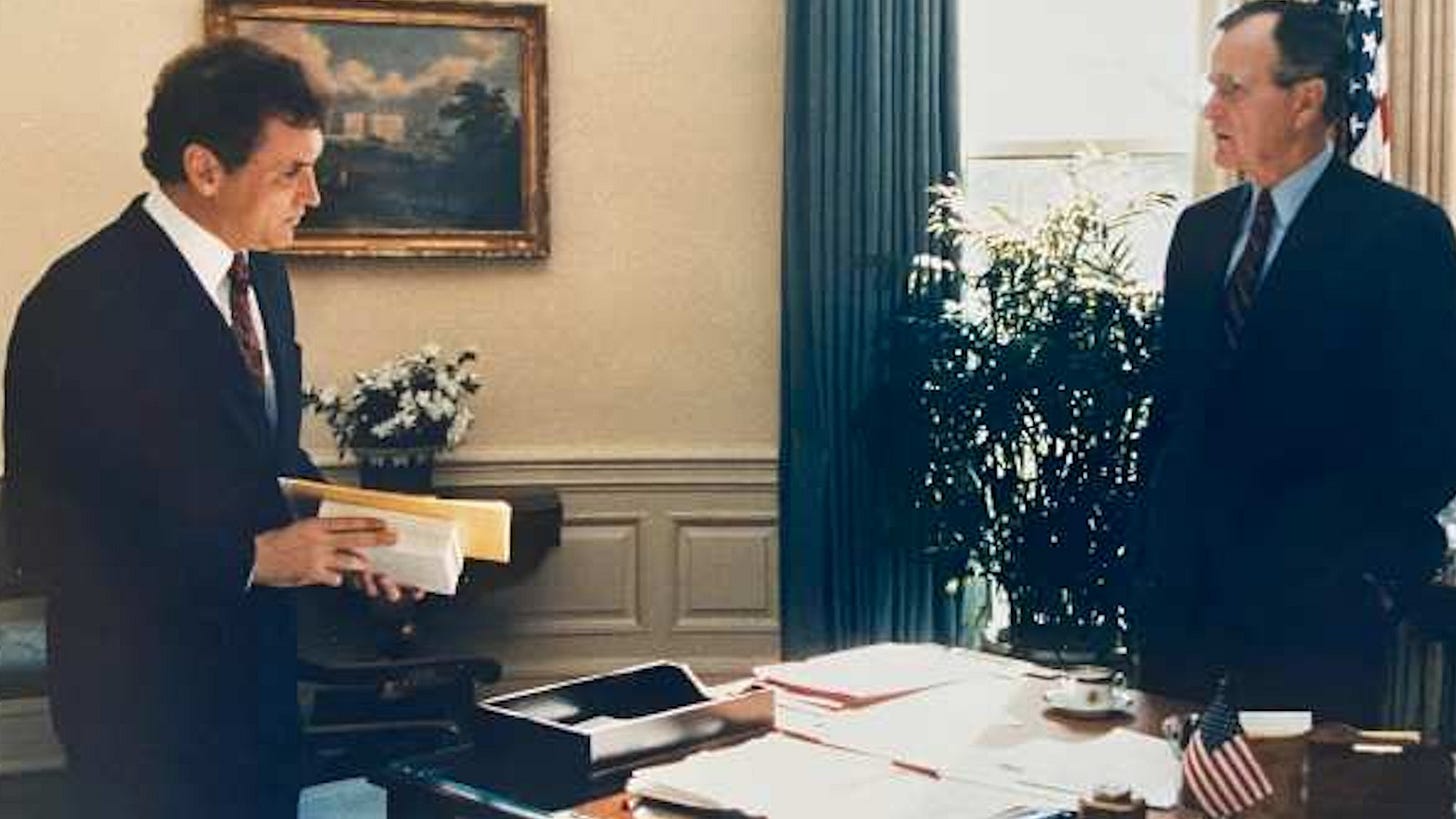
Reagan brought with him to the White House—or at least to Blair House—former Texas oil man and Republican Party chairman George Bush, whom Reagan didn’t much like and with whom he clashed frequently in the early days of the 1980 campaign. Somehow Wead became close to the Bush family, and at one point reported both to the elder Bush and the younger one, the then Vice-President’s son. But he did not actually work at the White House until Bush the First got there in his own right in 1989. Wead apparently gave up his Amway distributorship at this time and served as the conduit between the religious right and the Bush family. He was cashiered from the White House in 1990 when he objected to Bush inviting LGBT activists to the White House to a signing of a federal hate crimes bill. Though he insisted he was not personally homophobic, his opposition to soiling the sacred White House with gay people earned him significant cachet with homophobic wing of the Republican Party.
Two years later, Wead popped up in Arizona, running for a newly-created U.S. Congressional seat. He won the Republican nomination, but then the elder statesman of Arizona Republican politics, retired Senator and former 1964 Presidential candidate Barry Goldwater, shocked the state by endorsing Wead’s Democratic opponent instead of him. She went on to win. Wead claimed it was about abortion, but there might have been something else going on: Goldwater was notoriously skeptical of the religious right, as he stated in no uncertain terms in 1994 when he warned that if and when “preachers” get control of the Republican Party, “it’s going to be a terrible damn problem.”
With his own career in elected office scotched, Wead went on to advise the Bush family, and particularly George W. Bush. This eventually led to his political downfall. Wead secretly taped phone conversations between himself and George W. Bush while the latter was still Governor of Texas. In 2005, when Bush II was President, Wead released the tapes—which he thought were legal—but some of the revelations on them angered various conservatives, and the Bushes themselves.9 Wead went on to advise another political family, that being the Pauls—father Ron and son Rand—and wrote several books on Presidential history, none of which, in my opinion as a historian, are any good.
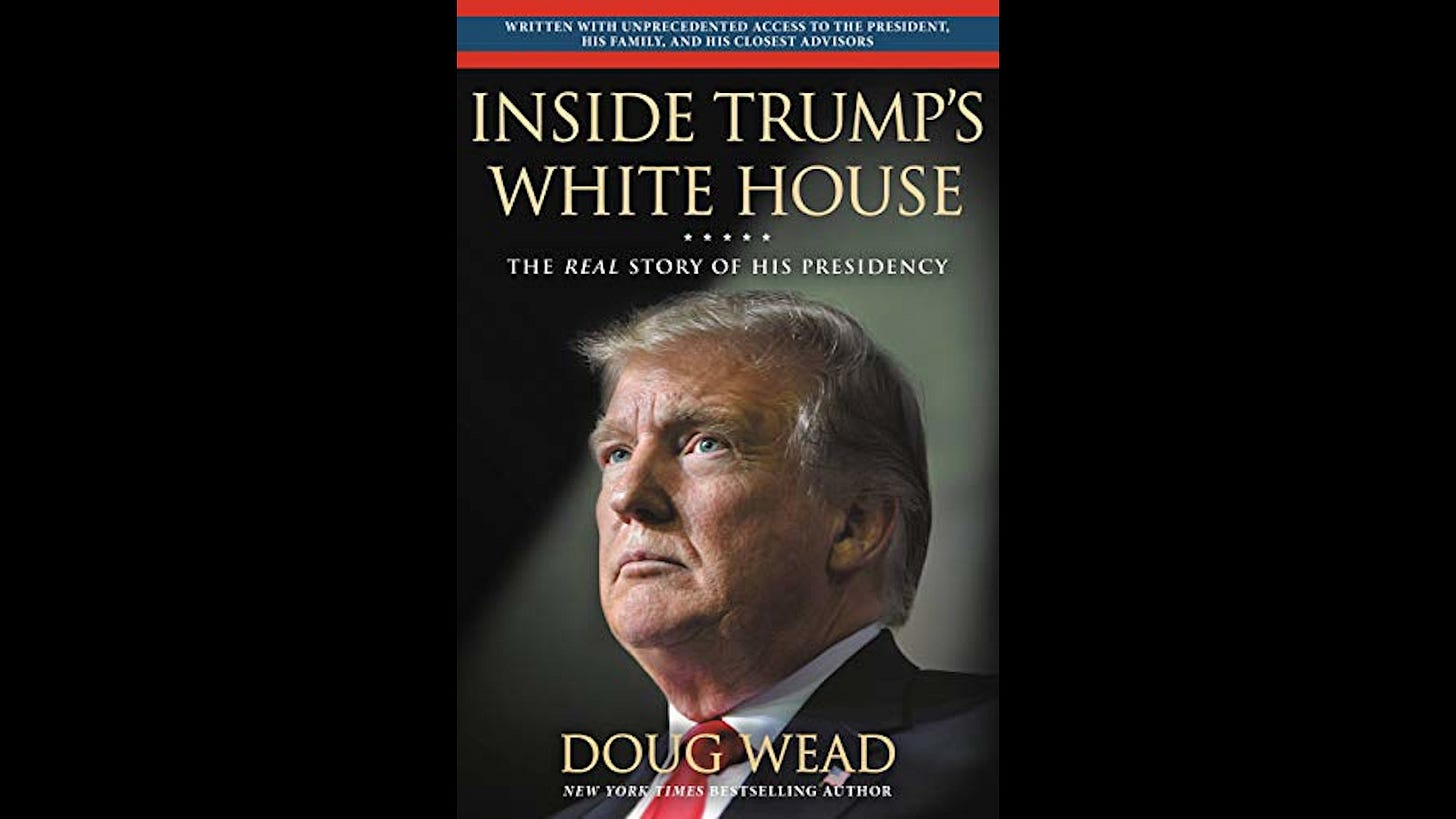
It’s unfortunate that Wead is the only source we have for that critical early ‘70s meeting between Yager, Britt and the “bright young man.” While I believe the factual matters Wead attests to are probably correct, he is unreliable because of his spin. The reporting on Wead—particularly Ward Harkavy’s series of stories for The Village Voice from 2005—makes clear that he was famously a chameleon, not wanting to say anything to offend anybody, and not above sandbagging the truth to that end. I found the origin story of the tools cult writings on his blog, dated 2009, when he was arguing with various online anti-MLM commenters. Wead’s take was “the tools are valuable but there are a few bad apples,” which is a common defense of the tools cult, and in any event he was never going to publicly say anything that wasn’t generally laudatory of Amway and multi-level marketing.
The unreliability of Wead as a source is similar to doing medieval or ancient history, where there is one or only a handful of sources about a particular battle, event, reign etc. and it or they are unreliable or problematic. As a historian you have to “read between the lines” to arrive at some reasonable conclusion of what actually happened.
The Battle with Amway
In 1975, Saigon fell to the North Vietnamese; Steven Spielberg’s Jaws made a generation of Americans afraid to go swimming; President Gerald Ford was shot at by Squeaky Fromme, a member of the Manson family, who was recruited using Dale Carnegie’s manipulation techniques. And in this year, the Amway Corporation began its epic, bruising battle with the Federal Trade Commission—a battle in which its survival as a company was on the line.
By now the FTC was on a roll, lining up and shooting down one multilevel marketing scam after another. They’d killed Holiday Magic and Koscot Interplanetary dog dead, and now they had their eyes on the biggest steer on the ranch: Amway.
Company execs Rich DeVos and Jay VanAndel had every reason to be concerned. Holiday Magic and Koscot had been a little more brazen in their get-rich-quick representations, but aside from that it was difficult for Amway to distinguish its basic pyramid-shaped business model from theirs. But the Amway suits did have a secret weapon that Holiday and Koscot did not have: the President of the United States.
Before Gerald Ford had the slightest inkling that he might one day be President, he was the longtime Republican Congressman from Grand Rapids, Michigan—right next door to the Amway founders’ hometown of Ada. Ford only got the top job because Nixon’s VP, Spiro Agnew, resigned during a bribery scandal, and according to the newly-passed 25th Amendment, Nixon nominated, and Congress approved, a new Vice-President. Then Nixon himself had his last day and the final wave on the steps of Marine One as a result of the Watergate scandal, and suddenly Grand Rapids’s own Congressman was in the White House.
DeVos and Van Andel wasted no time exploiting their connection to Ford. They visited him privately in the White House; the notes from the conversation, if there ever were any, have never surfaced, but we know for a fact they were there. While noting that correlation does not equal causation, it’s hard not to see the hand of official corruption in the result of the case.
In 1979, after four years of litigation, the infamous decision In re Amway Corporation was issued. The decision, which declared Amway was not pyramid scheme—even though it pretty much is—has been mischaracterized in anti-MLM circles. It was not the surprise ringing endorsement of Amway that it’s often made out to be. The decision was a functional victory for Amway in that it specified certain safe harbor conditions that, if they abided by them, would theoretically keep them from getting broken up as an illegal pyramid scheme. In reality, though, there’s evidence that the Amway suits understood that what they had really done was to fight the FTC to a draw. If they crossed the very thin line the FTC had drawn around their “legal” operations, the assault could be renewed again at any time. This may have been the deal, explicitly or implicitly, that the suits worked out with Ford during that mysterious White House meeting in 1975. Or there might not have been a deal at all; we may never know, but the Amway corporation continued to fear and dread the FTC for years afterward—so clearly they did not interpret the decision as a permanent absolution. This point becomes important.
In the meantime, the tools cult kingpins were getting very, very rich in the later 1970s. They quickly became a very insular group. Less than 2% of Amway distributors participate in the profits from the tools business, and 98% were never told that the major profits were being made there.10 Furthermore, the kingpins could keep their club closed and insular by picking and choosing who was allowed to quote-unquote “go Diamond.” They did this through transfers of points that conferred Amway pin levels.11 By transferring points and creating (or destroying) new Diamond distributors and their associated lines of business, the kingpins could effectively make the ownership of the tools business a sort of walled garden, with only a choice group of insiders admitted to share its riches. Dexter Yager was the biggest of the kingpins.
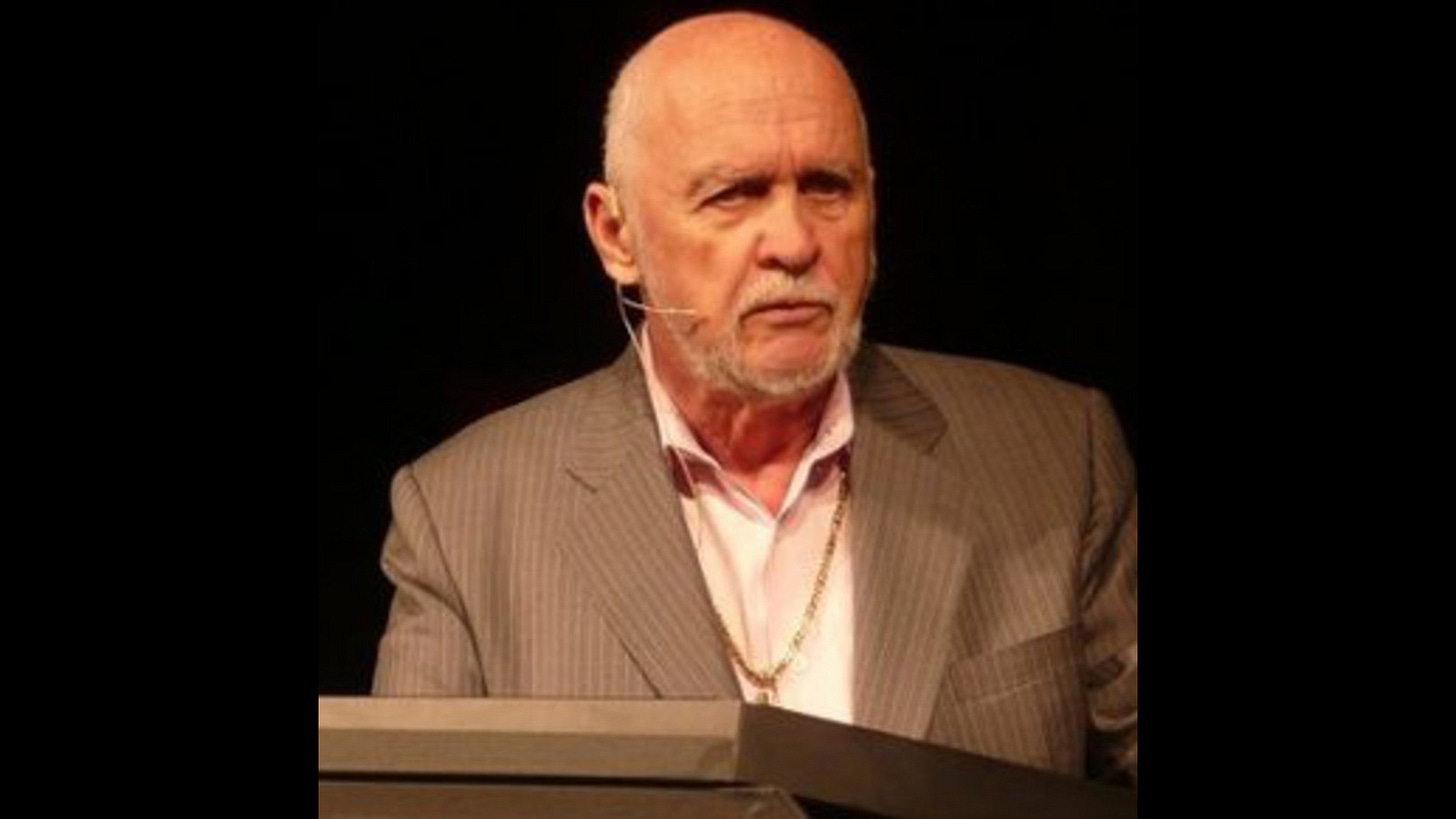
How rich was Yager? In 1980, the heyday of the tools business, Yager had a mansion outside Charlotte (to which Amway distributors flocked as a pilgrimage site), a collection of Rolls-Royces, yachts, and a coach that he used to transport himself ostentatiously to rallies—such as the immense Free Enterprise Days, held at a sports arena in Charlotte. This is the rally where people broke into the streets chanting “Five and six! Nights a week!”12
This was all part of the false image of success posed by the tapes and rallies themselves. It’s about material wealth. The message of the tools is never reflective or transformative. It’s never, get rich so you can find some sort of meaning in your life, get rich so you can go to Nepal and find spiritual enlightenment. It’s always, here is the coach/boat/mansion/fur coat, this is the meaning in life, no deeper reflection required. This evidently reflected Dexter Yager’s personal view of wealth and accomplishment. Note how this is also exactly the vision of wealth that comes out of “prosperity gospel” preachers like the Osteen family.
But the tools kingpins were careful to promote the impression that their wealth came from selling Amway products and recruiting distributors—not the tools business. The message was that if you work hard at Amway, again universally referred to as “this business,” you too will own the coach, boat, mansion and fur coats once you go Diamond.
Anecdotally, it was common lore among rank-and-file Amway distributors that “Amway produced more millionaires than any other business.” That’s patently and quantifiably false, of course,13 but it’s a lie that’s necessary to tell the distributors to keep them hooked. The truth—that any money made in Amway comes mostly from the tools cult—has to be carefully hidden.
Even a couple of minutes’ logical reflection can deflate Amway’s implicit promise of fabulous wealth. Realistically, how many soap millionaires can there be in America? And how could there be so many people who routinely get so rich selling a product that isn’t even available in retail stores? The tools kingpins were careful to keep people from asking these sorts of questions.
The reality was, of course, there were no soap millionaires, but there were tools cult millionaires. By 1990 Dexter Yager was pulling in $30 million a year and the vast majority of it came from tools. He flaunted his wealth by wearing diamond rings, a Rolex, and a bracelet spelling out his name in diamonds.14 Yager had by now set up a corporation, Freedom Distributing, which was the financial hub of his tools business. That company later in the ‘80s became InterNET Services Corporation—and eventually his motivational tape empire spewed its cultic rantings, many of them from Yager’s own speeches at rallies, into all 50 states and 10 foreign countries.15
The enormous growth of the tools cult reached its apex during the time that the Amway corporation was distracted by their long battle with the Federal Trade Commission. The historical evidence, particularly the Postma Memo (discussed in a moment), supports the inference that the Amway suits were surprised by how big and how pervasive the tools business had become—dwarfing by many times the revenues made by selling Amway-manufactured products to distributors. Or perhaps the suits did know, or suspected, but chose to ignore the problem for as long as possible. After all, Yager, Britt and their associated downlines accounted for the lion’s share of the Amway corporation’s profits. The real nature of Yager’s business was selling tapes, books and rally tickets; the Amway corporation did not get a piece of that, but what revenue they did get could exist only so long as the tools kingpins, the Diamonds, kept their downlines hooked on motivational tapes.
Then, finally, events forced Amway to pull its head out of the sand.
1982 was a terrible, terrible year for the Amway corporation. Sales were slowing down. The press was increasingly abuzz with negative stories about Amway—especially its dissatisfied ex-distributors who kept talking about how weird and culty it is. One of these was Phil Kerns, author of Fake It ‘Til You Make It, the first book-length exposé of Amway and the tools cult. Kerns, a former distributor, ironically once co-authored a book with none other than Doug Wead, about the People’s Temple, the suicide cult that resulted in over 900 deaths in Guyana in November 1978.
But what really drew the ire of the Amway suits is increasingly brazen behavior by some of the tools cult kingpins—or wanna-be kingpins. Sometime in late 1982, a West Coast distributor, Leonard Hall, went rogue. I know very little about Leonard Hall but what we do know, mostly from the Miami showdown tape, speaks for itself. Hall apparently saw the money being made in the tools cult and tried to make a grab for some of it. Though the majority of Amway distributors were wired into Yager’s group, not all were, and the tools were not ubiquitous in everybody’s downline. Hall tried to make a bid to build a “system” (a mini tools cult) of his own to cash in on the distributors who weren’t already addicted to tools. He went up and down California poaching distributors to join his line and thus get them hooked on his tools. This is the ultimate sin in Amway: “cross-lining.”
If we go back to the analogy of Amway being structured like the Mafia, “cross-lining” is like gangsters from one leg of the family going into business with another, separate branch—it would be viewed by the don as an act of disloyalty, and in any event would screw up the sanctity of the financial arrangements in the separate lines. For this reason, the Amway corporation, which does have some limited power to police its distributors, eventually terminated Leonard Hall’s distributorship.16
This was apparently not the only example of this. I found cryptic references to something similar occurring in Hawaii about the same time, but I couldn’t nail it down. Nevertheless, the attempts by small-fish distributors to leapfrog out of line and become tools kingpins caught the attention of the Amway suits in Ada, Michigan. In late 1982 they commissioned a comprehensive internal study of the entire tools business. This is how we got one of the most extraordinary documents in the history of multilevel marketing: the Postma memo.
The Postma Memo
On January 10, 1983, an Amway company lawyer named Ed Postma, head of Amway’s Business Conduct Division, sent a message to Patric Sullivan, Amway’s Director of Sales for the Northwest Region. The subject of the memo was, “Analysis of the Britt/Yager System.”17 This memo proves the animosity between the Amway corporation and the Yager tools organization. Postma said:
It is their feeling [meaning the Yager people] that no one at the company completely relates to their efforts in attempting to build the business and organization...There is a constant feeling of competition with the corporation.
The memo contains several smoking gun phrases.
In the words of one Diamond from the Northwest, ‘The Corporation should manufacture products and get out of the way.’ This sums up the extent of the relationship that these Diamonds wish to have with the company...It has been my judgment on observations, that they do not do a better meeting than we do, nor can they provide the same type of motivation as we do...However, in attempting to convince the corporation to stay out of the motivation business, it allows them to to two things: first, it further isolates the business, second, it allows them to operate a motivation business with little or no competition.
What Postma was referring to—“the same type of motivation that we do”—was the Amway corporation’s own very small library of motivational tapes. They did put out tapes and books occasionally. But their motivational operation was dwarfed by the Yager-Britt tools operation.
Postma continued:
[I]t becomes clear that although they [the Yager diamonds] realize that they are Amway distributors, they consider their personal business to be the motivation (tool) business. I think there is little question that this is where the big money is made. The motivation business is also where their primary allegiance lies.
There are numerous other gems from this memo. For instance, Postma dissected the rallies, on which he estimated Yager raked in $25 or $50,000 for a weekend, or $250,000 for Free Enterprise Days. He also documented how there were vendors present at these rallies who rented jewelry, flashy clothes and cars for Diamond distributors to use at rallies to appear successful. This is a flat out admission that the higher pins in Amway didn’t make the kind of money they claimed to make. And it was another layer of grift: in addition to their main business, the kingpins were making additional money on renting swag to distributors to make them appear rich. This also corroborated the main thesis of Phil Kern’s book Fake It ‘Til You Make It, and claims made later, in the 1990s and 2000s, by Eric Scheibeler and Ruth Carter.
Postma also said:
The tool business is illegal. Although the Amway business is legal...the tool business is not. It is a pyramid.
The Postma memo was not the only internal expose of the tools cult. Slightly earlier, sometime in 1982, there was a document titled “The Challenge of the ‘80s,” which warned the Amway Policy Committee that the illegality of the tools business threatened the very existence of the Amway corporation itself—in other words, they feared the FTC renewing the battle against them, which scared the hell out of them since they could not control the behavior of the tools kingpins. I also found reference to a warning, issued by a federal district court in Ohio, to the Amway corporation, titled, “Amway Distributor Compliance With The Code Of Ethics And Rules Of Conduct.” I could not find a copy of the original document itself, but another source that quoted it claimed that it said this:18
Widespread illegalities inherent in Amway distributor designed "systems" of tapes, books, and rallies. While most of these "systems" were conceived in the late 1960's and early 1970's as genuine "support" programs ... entrepreneurial "higher pins" discovered and developed programs for substantial, separate, additional income, under the Amway "umbrella.”
The hits kept coming for Amway. In early 1983, the news show “60 Minutes” ran an expose on Amway called “Soap and Hope.” It was mostly about whether income promises match up with reality, and also about the tools cult. Mike Wallace interviewed Dexter Yager and his wife Birdie. Surprisingly, Wallace went pretty easy on them and didn’t press the main issue which is whether his income is from the tools business or the Amway business, which 60 Minutes left open-ended.
Still, the 60 Minutes segment, and particularly the Leonard Hall debacle, evidently spooked the Amway suits enough that they finally decided to take action. In January 1983, right after the Postma memo, founders Rich DeVos and Jay Van Andel put out two of their own tapes called “Directly Speaking.” They were messages basically to the tools kingpins—the Diamonds—generally, and the Yager organization particularly.19 In these tapes, the Amway suits warned the kingpins about going too far with the tools business, and that it could call down the thunder on the whole Amway ecosystem (not explicitly stated, but probably what they meant: cause the FTC to renew the war against them). They warned the Diamonds about what’s euphemistically called “the curiosity approach,” which was the bait-and-switch approach used to trick people in prospecting meetings by not telling them that they were signing up for Amway.
The big bombshell was this: in “Directly Speaking,” the suits announced that they were going to start counting Amway-approved tapes toward distributors’ bonuses. But what the Diamonds took this to mean was that Amway was going to begin stepping up the business of its own tools to compete with the kingpins’ tool business.
This was nothing less than a declaration of war. Amway execs went coast to coast visiting the kingpins, who raged at them about how the corporation was trying to kill their businesses. The Amway suits’ response was, no, you don’t understand, what you’re doing is illegal, and if the FTC or the courts got involved they could destroy everything. There was apparently a big meeting in Hawaii to this effect, which is mentioned peripherally in various sources, including the Miami tape; but if a similar record of this meeting existed, it’s been lost to history.
Things finally came to a head at another fateful meeting between Amway corporate representatives and the tools kingpins. This meeting, a remarkable document of which has been preserved, is the climax of our story: the Miami showdown.
In the next installment: the tools cult kingpins confront the Amway executives face-to-face, and only one side remains standing. The next segment will be the conclusion of the story.
Sources
1Sources on Holiday Magic include Season 1 of the podcast The Dream, available on most podcast platforms (native to Stitcher).
2Gene Church & Conrad D. Carnes, The Pit: A Group Encounter Defiled (Outerbridge & Lazard, 1972).
3James Mann, “The Birchers & the Trumpers,” The New York Review, June 23, 2022 (https://www.nybooks.com/articles/2022/06/23/the-birchers-the-trumpers-john-birch-society-james-mann/).
4Jordan Morey, “Schaffer Could Head to Court Today,” The Republic, January 22, 2021 (https://www.therepublic.com/2021/01/22/schaffer-could-head-to-court-today/).
5“The Downline,” The Swindle (podcast), Episode 29 (https://swindledpodcast.com/podcasts/season-2/29-the-downline/).
6Harry M. Cochran, Jr., “Dare to Be Great, Inc.!: A Case Study of Pyramid Sales Plan Regulation,” Ohio State Law Journal, Vol. 33, 676-704 (1972) (source of quotes p. 6).
7Butterfield, p. 129.
8Major source for Wead material: Ward Harkavy, “Morning Report 2/21/05: The Tangled Roots of Doug Wead,” The Village Voice, February 21, 2005 (https://www.villagevoice.com/2005/02/21/morning-report-22105the-tangled-roots-of-doug-wead/).
9David D. Kirkpatrick, “From Psst to Oops: Secret Taper of Bush Says History Can Wait,” The New York Times, February 24, 2005 (https://www.nytimes.com/2005/02/24/politics/from-psst-to-oops-secret-taper-of-bush-says-history-can-wait.html).
10Statement of Andy Andrews (former Amway distributor), “Andy Andrews Amway Quixtar Team In Focus Tool Scam Anti-MLM Scam” (video), March 22, 2020 (link).
11Carter, p. 73-75.
12Butterfield, p. 163-78.
13“Amway Produces More Millionaires Than Any Other Type of System,” Ex-Cult.org (http://www.ex-cult.org/Groups/Amway/otherside/tosp16.htm).
14Eric G. Weinberg, "Creating Heaven on Earth: Jim Bakker and the Birth of a Sunbelt Pentecostalism," Theses and Dissertations—History 7 (2012), pp. 93-94.
15Jim Morrill & Nancy Stancill, “Yager Motivational Tapes Reel In Cash,” The Charlotte Observer, March 20, 1995 (http://www.ex-cult.org/Groups/Amway/dexter-yager-2.txt).
16“Hall, Leonard & Paula,” Amway Wiki (https://www.amwaywiki.com/Hall,_Leonard_%26_Paula).
17Link to the Postma Memo: https://web.archive.org/web/20120504013733/http://amquix.info/pdfs/postma-memo-1983.pdf
18Evelyn Pringle, “Bush Controls FTC While Amway Rips Off Millions,” Scoop Independent News, January 17, 2005 (https://www.scoop.co.nz/stories/HL0501/S00125/bush-controls-ftc-while-amway-rips-off-millions.htm).
19Rich DeVos, “Directly Speaking” [audio tape], January 1983, transcription: https://web.archive.org/web/20060422014637/http://www.amquix.info/amway_directly_speaking.html.
☕ If you appreciate what I do, buy me a virtual coffee from time-to-time to support my work. I know it seems small, but it truly helps.
📖 You could also buy my book, which I wrote in part to take my mind off climate anxiety.
🎓 Like learning? Find out what courses I’m currently offering at my website.
📽 More the visual type? Here is my YouTube channel with tons of free history videos.
💌 Feedback to share or want to say hello? Hit reply on this email or leave me a comment on Substack.






